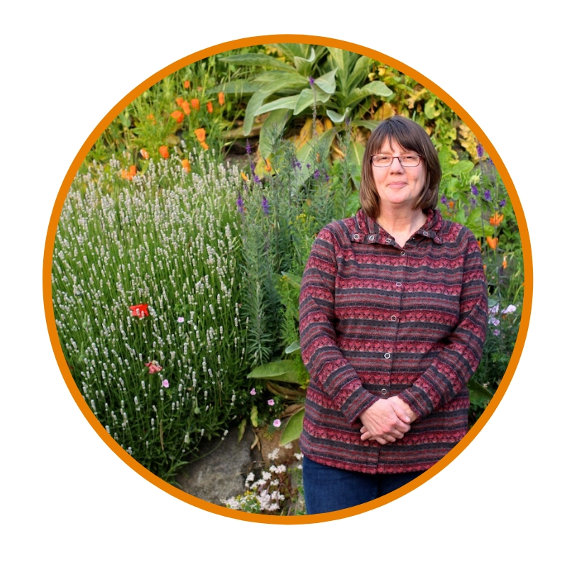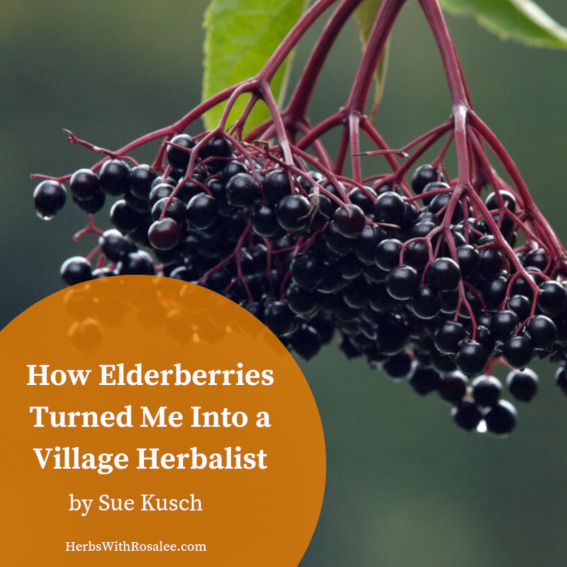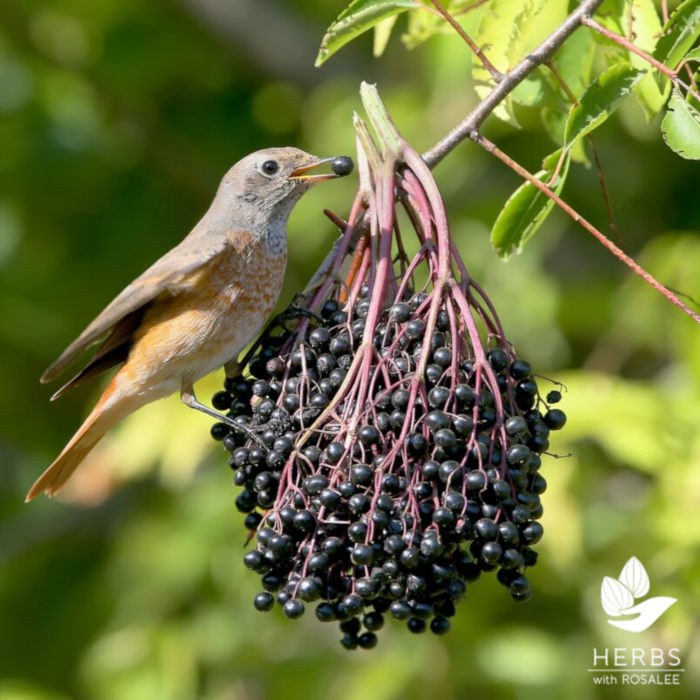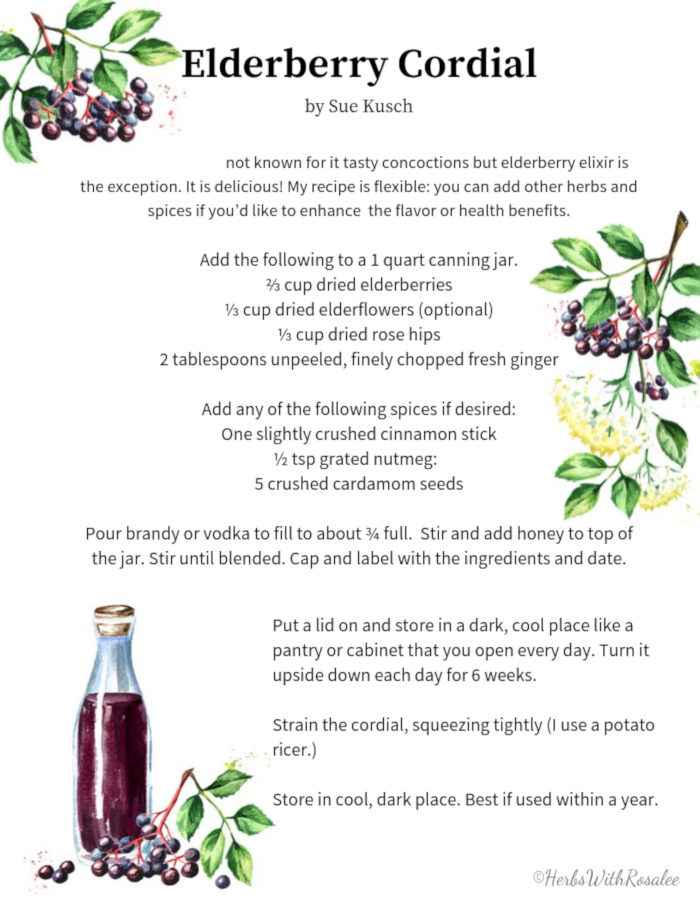Get weekly tips, recipes, and my Herbal Jumpstart e-course! Sign up for free today.

Elderberry Uses
Share this! |
|
Until ten years ago I lived in urban and suburban environments and, to be honest, never really knew my neighbors. When I moved to my rural location ten years ago, I met my neighbors almost immediately. We exchanged phone numbers and, over the years, we have developed friendships that include weekly walks and occasional gatherings. Though each of us is self-reliant and values our solitude, we are also aware that we must turn to each other for help now and then.
One day in my first August here, I strolled down the road with a bucket and began harvesting ripening elderberries. One of my neighbors walked by and asked why. I enthusiastically shared practically everything I had learned about the benefits of elderberry. She listened politely and smiled that smile that many herbalists experience: curious, skeptical and a bit amused. As she continued on, I thought to myself, “It’s official...I am now the crazy herb lady in the neighborhood.”
Over the next year, I met more residents in our remote neck of the woods and, by then, I was making handcrafted herbal remedies, teas, balms and seasonings and selling them at the local farmer’s market. I made an array of products but the ones that consistently sold and that people would ask about were elderberry remedies. I made elderberry tincture and recommended its use at the first symptoms of a viral infection. I created an elderberry syrup kit that included dried elderberries, dried ginger and a cinnamon stick and recommended it for both illness and pancakes. I had been making and using elderberry cordial to support my immune system so I began to bottle that and sell it. I added dried elderberries, along with dried elderflowers, to the well-known Cold Care tea and, after multiple requests, I began to dry large quantities of elderberries and sell them in 8 oz. bags, along with my recipe for Elderberry Elixir.
My sales reflected one consistency: people believed in the medicinal properties of elderberry.
My second winter here was snowy and icy cold and my neighbor contacted me about that “elderberry stuff” I had mentioned. She works in our public school system, is exposed regularly to viral infections and almost always ends up with a severe cold and, on a couple of occasions, she suffered through an influenza infection. I delivered a jar of cold care tea, elderberry extract and a small batch of elderberry syrup. Several days later, she called to thank me profusely, claiming that she felt better within 24 hours after taking the remedies as I advised. She returned to work and shared her elderberry experience with her co-workers, and I soon sold out of all of my elderberry products!
Over the years, other neighbors began requesting their own viral care
elderberry package. Finally, one day several of us got together for a
glass of wine and one of my neighbors asked the magical question: Why do
the elderberry remedies seem to work better than over-the-counter (OTC)
products? Well, you don’t have to ask me twice to explain the basics of
herbal medicine!
I reviewed the basic function of our immune system
and its ability to resist infection and that herbal medicine is
traditionally used to support the systems of our bodies by nourishing
and strengthening them. But modern research is now offering us evidence
of specific ways that some herbs work, and elderberry is thought to
prevent replication of viral cells by blocking their ability to enter
into cell walls.
When I mentioned that OTC cold and flu
products are designed to suppress our symptoms and that relief often
gives us permission to resume our daily routines instead of resting, my
friends nodded in agreement. At that point, one of them exclaimed, “I
don’t care how it works, I just know it does, and I am happy to know you
make this stuff.”
That is the difference between an herbalist and an herbal consumer!
After
several years, I closed my herbal products business to focus on writing
and teaching about growing food and herbal medicine. Because I am
surrounded by hundreds of elderberry shrubs, I continue to harvest
elderflowers in early summer and many pounds of elderberries in late
summer. I make a quart of elderberry tincture, a pint of elderflower
extract, a half gallon of Cold Care tea and multiple gallons of
elderberry cordial. And on the winter Solstice of each year, I package
up my elderberry medicine with dosage directions and deliver them to my
neighbor-friends, wishing them the best of health for the season. My
friends express much gratitude for their annual herbal gifts from their
village herbalist.
Elderberry Uses: Elderberry Cordial Recipe
What does one do with gallons of elderberry cordial (AKA elixir)? Drink a bit each day to support your immune system against viral infections, reduce inflammation associated with arthritis and support your eye health.
In my herbal studies, I came across two references for elderberry uses for various types of neuralgia. For years, I suffered with occasional bouts of trigeminal neuralgia, which causes searing pain along the trigeminal nerve that encircles the cranium. I had pharmaceutical drugs that eliminated the pain but the side effects included extreme drowsiness, lethargy and brain fog for a day or two after taking them. Eight years ago, I started drinking half an ounce of elderberry elixir each day, and my neuralgia attacks have almost completely disappeared.
Herbal medicine is not known for it tasty concoctions but elderberry elixir is the exception. It is delicious! My recipe is flexible: you can add other herbs and spices if you’d like to enhance the flavor or health benefits.
Elderberry Cordial Ingredients
- ⅔ cup dried elderberries
- ⅓ cup dried elderflowers (optional)
- ⅓ cup dried rose hips
- 2 tablespoons unpeeled, finely chopped fresh ginger
Add any of the following spices if desired:
- One slightly crushed cinnamon stick
- ½ tsp grated nutmeg:
- 5 crushed cardamom seeds
Elderberry Cordial Directions
Add the ingredients to a 1-quart canning jar. Pour brandy or vodka to fill to about ¾ full. Stir and add honey to top of the jar. Stir until blended. Cap and label with the ingredients and date.
Put a lid on and store in a dark, cool place like a pantry or cabinet that you open every day. Turn it upside down each day for 6 weeks. Strain the cordial, squeezing tightly (I use a potato ricer.). Store in a cool, dark place. Best if used within a year.
I reuse the marc (leftover herbal material) to make 2 cups of “juice” that I freeze as ice cubes.
J

Sue Kusch, a former community college instructor and academic advisor, incorporates her experiential wisdom, expertise and science-based research garnered from her three decades of growing vegetables, fruit and herbs into her educational writing about plants and how people use them. In addition to her BA in Social Sciences and Masters in Education, she completed the Master Gardener training in 2011 and two permaculture courses in 2001 and 2014. She has studied medicinal and nutritional uses of herbs, including studies at Herbmentor and East West School of Planetary Herbology, since 1997. An avid reader, lover of historical and folkloric information, and a promising storyteller, Sue writes about the intersection of plants and people.


